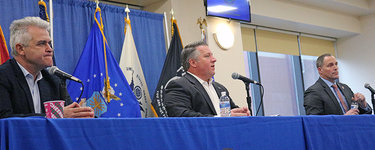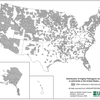In battle against virus, McCoy says, ‘We’re one in the Capital District’
ALBANY COUNTY — Leaders from nearby Rensselaer and Schenectady counties joined Albany County Executive Daniel McCoy, a Democrat, at his Saturday morning press conference to present a united front in the battle against COVID-19.
“It’s been a sudden brotherhood of step brothers almost,” said Rory Fluman, a Democrat who started as Schenectady County’s manager in 2019.
“There’s a lot of interplay,” said Steve McLaughlin, a Republican, who became Rensselaer County’s executive in 2018. He cited the recent case of a COVID-19 patient who lived in Rensselaer County, worked in Schenectady County, and had contacts in Albany County.
He noted that Rensselaer, as a less populous county than Albany, had fewer cases — 2,087 since March compared to Albany County’s 6,501 — with 447 active cases compared to Albany County’s 1,106, and with 17 patients currently hospitalized compared to Albany County’s 89.
It’s important to get the numbers “back under control,” said McLaughlin. “We’ve got to make sure our hospitals do not get overrun.”
Albany Medical Center is a regional hospital, McCoy noted, just as Fluman noted Ellis Hospital in Schenectady is too. The state required all hospitals to come up with surge-and-flex plans in the spring, Fluman noted, adding that now, “They had to dust them off.”
“The region has already exceeded its peak in the spring for hospitalizations,” said McCoy.
Regionally, he said, during the springtime peak, roughly 205 patients were hospitalized with COVID-19 with about 100 in intensive-care units. Currently, though, the ICU numbers have been been in the low 30s.
Those are the numbers the governor’s team has been focusing on, said McCoy, calling the number of patients currently on ventilators or in ICUs in the Capital District “really good.”
All three county leaders are waiting for guidance on Governor Andrew Cuomo’s winter plan for dealing with COVID-19, which still focuses on micro-cluster zones to control outbreaks but will change the metrics for declaring the zones as well as the requirements to be followed.
“We are all probably closer than any of us want to be,” said McLaughlin of being named a zone.
Fluman said of the governor and the state’s health department, “That they’re tweaking their guidance based on experience in other parts of the state is smart governing to me.” Speaking of the yet-to-be-released state guidance, he said “When that happens, we’re all ready.”
“Early on, out of the governor’s office, it was all about test, trace, and isolate,” said Fluman. While those remain “core functions,” he said that now, “It’s all about the spread.”
Fluman went on, “We’re in this spot now Fauci is calling a surge upon a surge. We had Thanksgiving just last week so the numbers are rising and we’re seeing them starting to explode frankly and with that explosion is community spread.”
He concluded, “I think it’s important we’re here in unity … to spread this message.”
McLaughlin said that the holiday season can be “a very tough time of year for a lot of folks who get lonely and depressed.” He noted drastic increases in suicides and in drug overdoses.
“Right now, we still have more drug overdose deaths than COVID deaths,” said McLaughlin of Rensselaer County. He said drug-overdose deaths were double the number from 2019 “and we’re not through the years yet … Same thing with suicide.”
“Our numbers are higher this year than last year,” said McCoy of overdose deaths in Albany County. He added, “It was alarming.” It can be difficult for addicts to get therapy through teleconferencing, McCoy said, stating that many need face-to-face comfort and support.
“COVID has caused community stress,” agreed Fluman, “and with that, unfortunately, people will turn to those illegal things and to other things, whether it’s arguing with your wife, kicking your dog, drinking too much beer.”
All three county leaders urged residents to turn to their county government for needed social services. They also expressed support for the current $980 billion COVID relief package currently being considered by Congress.
“Federal bailout and federal rescue are very important so we can sustain and monetize all these programs of testing and tracing,” said Fluman.
McCoy agreed, saying, “More people are on assistance than ever before … people needing housing, people needing to put food on the table and that’s what we do,” he said of county governments.
McCoy said, regardless of political party, or religious beliefs, or other differences, “We’re one in the Capital District.” He said of the role of county leaders, “It’s about helping our people” and noted how neighboring counties had shared personal protective equipment and other equipment when there was a need.
“We are working across county borders, party affiliations … It’s about working together and working for the people …,” said McCoy. “When we intermix our staffs and get things done, it benefits everyone as a whole.”
He also urged the public, “Help us help you.”
Newest numbers
Statewide, the positive testing rate, based on Friday’s results, was 4.99 percent, which includes 6.17 percent for all of the micro-cluster zones combined, according to a Saturday release from Cuomo’s office.
The Capital Region, of which Albany County is a part, had a seven-day average of 4.32. Of the state’s 10 regions, the Southern Tier continues to have the lowest rate, at 2.63 percent, while Westrn New York continues to have the highest rate, at 7.44 percent.
Albany County, as of Saturday morning, had 6,501 confirmed cases, including 177 new cases, Mccoy announced.
Of the new cases, 19 had close contact with positive cases, 141 did not have a clear source of infection identified at this time, three reported traveling out of state, and 14 are health-care workers or residents of congregate settings.
The five-day average for new daily positives increased to 165 from 150.6. There are now 1,106 active cases in the county, a huge increase from 992 on Friday. The number of people under mandatory quarantine decreased to 2,191 from 2,218.
So far, 25,412 Albany County residents have completed quarantine. Of those, 5,395 had tested positive and recovered.
There were 16 new hospitalizations reported overnight, and there are 89 county residents currently hospitalized from the virus — a net decrease of seven from Friday. The hospitalization rate is now 1.36 percent. There are currently 14 patients in intensive-care units, down from 16 yesterday.
Albany County’s COVID-19 death toll remains at 167.



